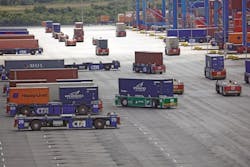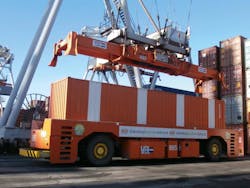So earlier this month, global logistics provider DHL issued what it calls a “trend report” entitled Self-Driving Vehicles in Logistics.
The nearly 40-page study penned by Markus Kückelhaus, director of DHL trend research, provides an in-depth look at the many technological, regulatory, and societal acceptance hurdles ahead for autonomous or “self-driving” vehicles – some of which I’ve detailed in this space previously.Yet no one should be surprised to discover that autonomously guided vehicles or “AGVs” are a regular fixture in manufacturing plants and warehouses all over the world these days – indeed, many of the plants crafting engines and even tires for the trucking industry rely on self-guided transporters in every-day operation.
And it’s that long-term experience that Kückelhaus (at left) believes will foster wider use of AGV technology to move goods in over-the-road applications.
“Some warehouse operations have been using self-driving vehicles to some extent for years, but making driving in logistics more and more autonomous will change the logistics sector dramatically,” he explained. “Moving onto public roads is the next evolutionary step. With its history in deploying self-driving solutions in controlled environments, the logistics industry is in a prime position to further shape the future of self-driving vehicles.”
A first step in this direction is taking place in ports and freight yards across the globe, specifically to maneuver and re-position containers and pallets in what are often highly congested areas, thereby removing humans from danger’s path.In DHL’s trend report, Kückelhaus pointed to the Harbor Container Terminal Altenwerder in Germany, where container handling is almost completely automated thanks to a fleet of 84 driverless battery-powered vehicles that transport freight containers between wharves and storage areas by themselves; navigating routes by tapping into a network of 19,000 transponders installed in the ground.
“This greatly increases the speed and efficiency of container handling in comparison to traditional transport methods using trucks and cranes, highlighting the key elements and significant potential of autonomous technologies in the logistic industry,” Kückelhaus said.
He also believes such “self-driving” systems could be deployed at airports to transport cargo-carrying unit load devices or “ULDs” to and from the airport terminal gate and each plane. The next step might be the automated handover to a self-driving ULD transporter which automatically loads and unloads each plane, Kückelhaus added.
There’s an energy-saving component to such “self-driving” vehicles, too, as the aim of the Altenwerder container transport effort is to charge the batteries of its AGVs when the northern Germany’s electrical grid has a surplus of energy during “off-peak” hours.“This will enable us to take intelligent electricity management to the next level together … linking the future battery administration system with our load forecasting system and the terminal management system to identify suitable charging windows,” noted Oliver Weinmann, managing director of Vattenfall Innovation GmbH, a Europe-based renewable energy firm that’s a partner in this project. “If we succeed in realizing clear cost reductions with this intelligent charging strategy, other logistics applications could also benefit from it."
DHL’s Kückelhaus also noted another interesting possibility where such “self-driving” freight vehicles are concerned: the concept of a self-driving “Packstation” to handle “last-mile” deliveries to customers.
“While today, the customer must go to a central repository to retrieve their shipments, a ‘Packstation’ could autonomously come closer to them,” he explained. “[Like] a municipal library bus, it could stop at designated locations at certain times and open its doors to the public ... all without a driver. Such self-driving repositories could become a model for mobile delivery [of shipments] in the future.”
They could also provide a necessary “first step” to exposing both the public and freight operators to the potential self-driving vehicles have to offer. We'll see if that works out.



